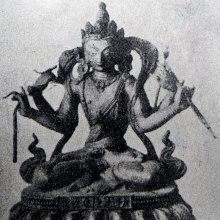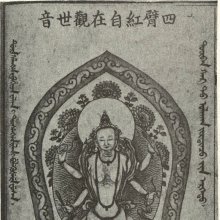Raktalokeshvara, Raktalokeśvara, Rakta-lokeshvara: 1 definition
Introduction:
Raktalokeshvara means something in Buddhism, Pali. If you want to know the exact meaning, history, etymology or English translation of this term then check out the descriptions on this page. Add your comment or reference to a book if you want to contribute to this summary article.
The Sanskrit term Raktalokeśvara can be transliterated into English as Raktalokesvara or Raktalokeshvara, using the IAST transliteration scheme (?).
Images (photo gallery)
In Buddhism
Tibetan Buddhism (Vajrayana or tantric Buddhism)
Source: archive.org: The Indian Buddhist IconographyRaktalokeśvara (रक्तलोकेश्वर) or simply Rakta refers to one of the various forms of Avalokiteśvara having their Sādhana described in the 5th-century Sādhanamālā (a collection of sādhana texts that contain detailed instructions for rituals).—Two Sādhanas in the Sādhanamālā are devoted to his [i.e., Raktalokeśvara’s] worship, but the two Dhyānas describe two widely different forms of the god.
Raktalokeśvara (four-armed variety).—[His Colour is red; his Companions are Tārā and Bhṛkuṭī]—The Dhyāna in the Sādhanamālā is as follows:
“The worshipper should think himself as Ārya-Avalokiteśvara, who is flanked in his right and left by the two goddesses Tārā and Bhṛkuṭī. He is red in colour, wears red garments and is besmeared with red unguents. He carries in his four hands, the noose, the goad, the bow and the arrow, and stands under the Aśoka tree, which has blossomed into red flowers”.
[The colophon of the Sādhana attributes to him the name of Rakta-Lokeśvara and this name is given simply because his colour is red. Images of Rakta-Lokeśvara are rare. A few can be seen in the Kva Vahal at Pattan in Nepal. Statuettes of Rakta-Lokeśvara are found in China under the title of Caturbhuja-Avalokiteśvara.]
Raktalokeśvara (two-armed variety).—[His Colour is red; his Symbol is the lotus; his Mudrā is the ‘opening of the petals’]—The Dhyāna in the Sādhanamālā is as follows:
“The worshipper should think himself as Rakta-Lokeśvara of red colour, having a jaṭāmukuṭa (crown of matted hair) bearing the effigy of Amitābha. He carries the red lotus in the left hand, and opens its petals with the right and is decked in various ornaments and dress.”
[This two-armed form is not met with either in painting or in stone... A reference may here be made to the Dhyāna of Vajradharma another variety of Lokeśvara, equally unrepresented, whose form will be described later in this chapter. The forms of Rakta-Lokeśvara and Vajradharma are almost identical with the difference that the Sādhana enjoins for Vajradharma, the Vāhana of a peacock. ]

Tibetan Buddhism includes schools such as Nyingma, Kadampa, Kagyu and Gelug. Their primary canon of literature is divided in two broad categories: The Kangyur, which consists of Buddha’s words, and the Tengyur, which includes commentaries from various sources. Esotericism and tantra techniques (vajrayāna) are collected indepently.
See also (Relevant definitions)
Partial matches: Lokeshvara, Rakta.
Full-text: Rakta.
Relevant text
Search found 3 books and stories containing Raktalokeshvara, Raktalokeśvara, Rakta-lokeshvara, Rakta-lokeśvara, Rakta-lokesvara, Raktalokesvara; (plurals include: Raktalokeshvaras, Raktalokeśvaras, lokeshvaras, lokeśvaras, lokesvaras, Raktalokesvaras). You can also click to the full overview containing English textual excerpts. Below are direct links for the most relevant articles:
The Indian Buddhist Iconography (by Benoytosh Bhattachacharyya)
Sripura (Archaeological Survey) (by Bikash Chandra Pradhan)
Scultures of Rakta-Lokesvara < [Chapter 3 - Sculptural Programme]
Scultures of Bodhisattvas < [Chapter 3 - Sculptural Programme]
Bronze-icons < [Chapter 3 - Sculptural Programme]
The gods of northern Buddhism (by Alice Getty)
Related products

